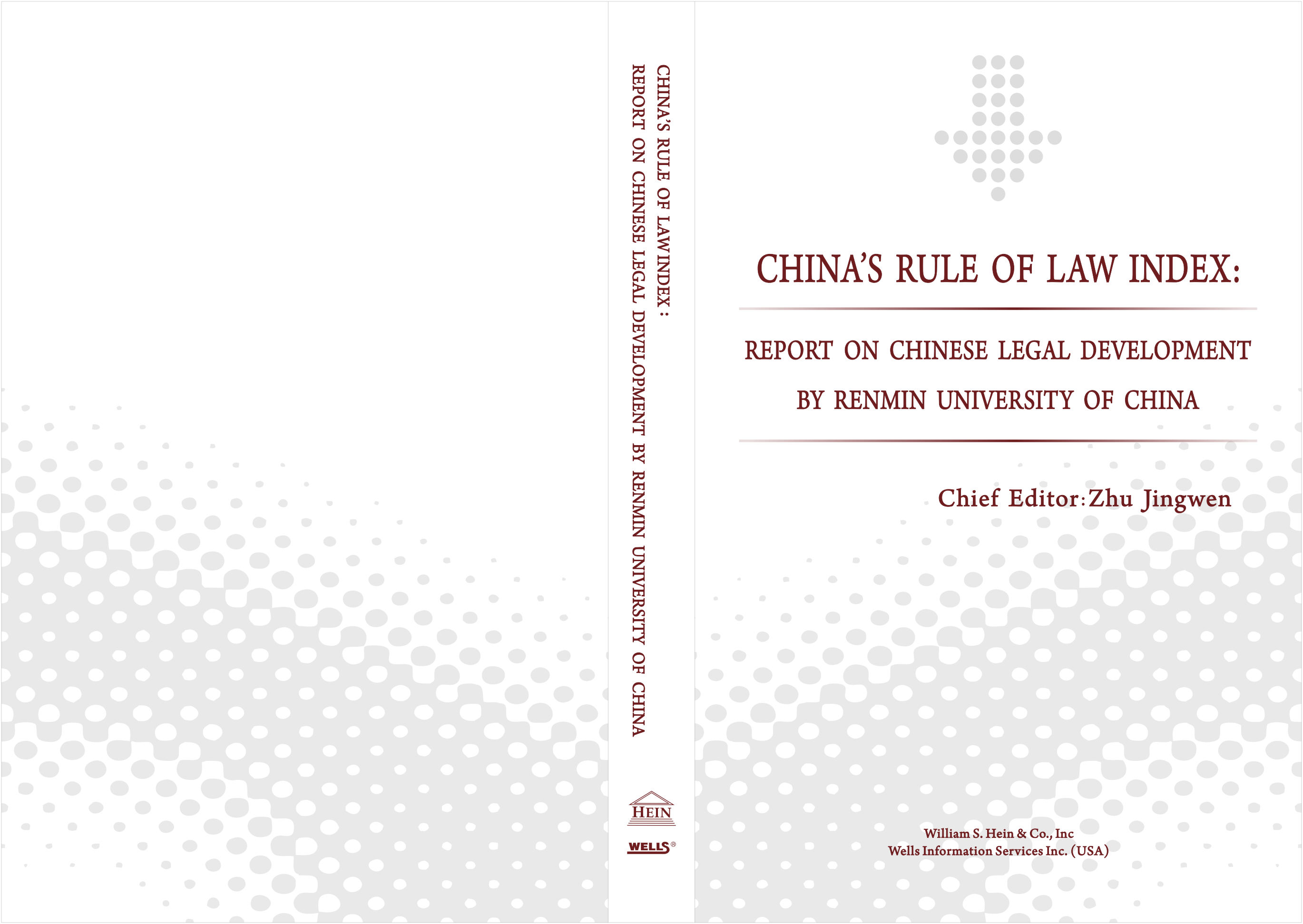CHINA’S RULE OF LAW INDEX: REPORT ON CHINESE LEGAL DEVELOPMENT
摘要
PREFACE China’s Rule of Law Index is a result of the co-researches of the “Innovation of Evaluation of the Rule of Law in China and its Generalization and Implementation” supported by the Major Issues of the National Social Science Foundation and the “Fundamental Theories of the Evaluation of the Rule of Law” supported by the Major Issues of Beijing Federation of Social Science Circles and Major Issues of Renmin University of China Development Report. The National Academy of Development and Strategy of Renmin University also contributed to this research. The Evaluation Center of the Rule of Law of Renmin University of China was approved by the China Law Society as the latter’s research base in early 2016. The Politics and Law Committee of the CCP Central Committee decided to appoint the center to execute its 2016 Project Research concerning “The Evaluation System and Mechanism of the Situation of the Rule of Law of Socialism with Chinese Characteristics.” All the parties mentioned above have supported, encouraged, and confirmed this research. This index is derived from the series of Report on China Law Development. This report is annually compiled and includes 2007 Report on China Law Development: Database and Index,1 2010 Report on China Law Development: 60 Years of China Legislation,2 2011 Report on China Law Development: Towards a Pluralistic Implementation of Law,3 2012 Report on China Law Development: Professionalization of China Law Practitioners,4 2013 Report on China Law Development: Legal Education and Research,5 and 2014 Report on China Law Development: Construct Government of the Rule of Law.6 All these reports were based on objective statistics concerning specific areas. These reports aim to arrange the statistics according to a certain system of indicators. China’s Rule of Law Index is also a 2015 Report.7 This index is unique as it is based on a subjective evaluation where all the statistics are derived from a first-hand questionnaire survey conducted in late 2015. This index is the first subjective evaluation of the rule of law in China, reflecting various strands of the development of the rule of law. 1 (Report on China Law Development: Database and Indicators), Renmin University of China Press, 2007. 2 (Renmin University of China Report on China Law Development 2010: China Lawmaking 60 Years), Renmin University of China Press, 2011. 3 (Renmin University of China Report on China Law Development 2011:Law-Enforcing Towards Pluralism), Renmin University of China Press, 2012 4 (Renmin University of China Report on China Law Development 2012: Professionalization of China’s Legal Workers), Renmin University of China Press, 2013 5 (Renmin University of China Report on China Law Development 2013: Legal Education and Research), Renmin University of China Press, 2014. 6 (Renmin University of China Report on China Law Development 2014: Construction of Legal Government), Renmin University of China Press, 2015. 7 (Renmin University of China Report on China Law Development 2015: China Indicators of the Rule of Law), Report on China Law Development: China Indicators of the Rule of Law, (zhongguo falvfazhan baogao 2015: zhongguo fazhi pinggu zhibiao) Renmin University of China Press, 2016. x CHINA’S RULE OF LAW INDEX The Evaluation Center for the Rule of Law of Renmin University of China is responsible for drafting this report. The division of labor is as follows: 1. General Framework Designers Indicator design: ZHU Jingwen (professor at Renmin University of China Law School and director at the Evaluation Center for the Rule of Law); Questionnaire design and statistic counting: RAN Jingfu (associate researcher at the Institute of Law of Chinese Academy of Social Sciences); Questionnaire survey: WANG Weidong (deputy director at National Survey Research Center of Renmin University of China and associate professor at Renmin University of China, Ph.D. in sociology) 2. Drafting Team Members Introduction: ZHU Jingwen Chapter 1 Legal Norm System by FENG Yujun (professor at Renmin University of China Law School, Ph.D. in law); Chapter 2 Enforcement System of the Rule of Law by RAN Jingfu (project leader, 2.2 Indicators of Judicial Enforcement); MENG Tao (associate professor at Renmin University of China Law School, Ph.D. in law, 2.1 Indicators of Executive Enforcement); PENG Xiaolong (associate professor at Renmin University of China Law School, Ph.D. in law, executive director at Multiform Dispute Resolution Center of Renmin University of China, 2.3 Indicators of Social Governance); Chapter 3 Supervision System of the Rule of Law by MENG Tao (project leader, 3.2 Indicators of Executive Supervision); FENG Yujun (3.1 Indicators of Document Supervision); RAN Jingfu (3.3 Indicators of Judicial Supervision); Chapter 4 Safeguard System of the Rule of Law by PENG Xiaolong (project leader, 4.2 Indicators of Financial Safeguard); RAN Jingfu (4.1 Indicators of the Personnel Safeguard); LIU Kunlun (associate professor at China University of Political Science and Law, Ph.D. in law, executive director at Research Center of Legal Education, 4.3 Legal Education and the Popularization of Law); Chapter 5 CCP’s Rules and Regulations by WANG Lifeng (professor at the Department of Politics and Law of Party School of the Central Committee of CCP, Ph.D. in law); Chapter 6 Effectiveness System of the Rule of Law by ZHU Jingwen (project leader); WANG Lifeng (6.1 Indicators of Power Control); YE Chuanxing (associate professor at Renmin University of China Law School, Ph.D. in law, deputy director at the Human Rights Center of Renmin University of China, 6.2 Indicators of Human Rights); SHI Yan’an (professor at Renmin University of China, Ph.D. in law, executive director at Research Center for Criminal Justice of Renmin University of China, 6.3.1 Community Security, 6.3.2 Social Order); PENG Xiaolong (6.3.3 Dispute Resolution Mechanism); LIU Kunlun (6.4 Notions of the Rule of Law) Conclusion: ZHU Jingwen Editor-in-Chief: ZHU Jingwen ZHU Jingwen March 2016 at Shi Ji Cheng, Beijing
正文
备注
中华学术外译项目 Wells-Hein联合出版“中国法律与社会” China Law & Society Library系列。 全文电子版336页





